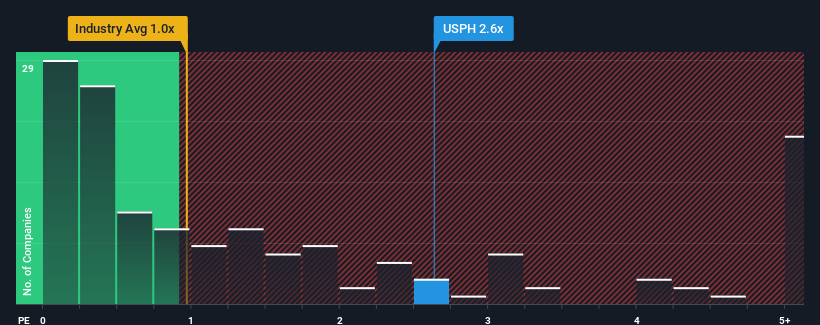- United States
- /
- Healthcare Services
- /
- NYSE:USPH
U.S. Physical Therapy, Inc.'s (NYSE:USPH) Shareholders Might Be Looking For Exit

When you see that almost half of the companies in the Healthcare industry in the United States have price-to-sales ratios (or "P/S") below 1x, U.S. Physical Therapy, Inc. (NYSE:USPH) looks to be giving off some sell signals with its 2.6x P/S ratio. Nonetheless, we'd need to dig a little deeper to determine if there is a rational basis for the elevated P/S.
Check out our latest analysis for U.S. Physical Therapy

What Does U.S. Physical Therapy's Recent Performance Look Like?
U.S. Physical Therapy could be doing better as it's been growing revenue less than most other companies lately. One possibility is that the P/S ratio is high because investors think this lacklustre revenue performance will improve markedly. You'd really hope so, otherwise you're paying a pretty hefty price for no particular reason.
Keen to find out how analysts think U.S. Physical Therapy's future stacks up against the industry? In that case, our free report is a great place to start.How Is U.S. Physical Therapy's Revenue Growth Trending?
There's an inherent assumption that a company should outperform the industry for P/S ratios like U.S. Physical Therapy's to be considered reasonable.
If we review the last year of revenue growth, the company posted a worthy increase of 9.3%. This was backed up an excellent period prior to see revenue up by 43% in total over the last three years. Accordingly, shareholders would have definitely welcomed those medium-term rates of revenue growth.
Looking ahead now, revenue is anticipated to climb by 7.3% each year during the coming three years according to the six analysts following the company. That's shaping up to be similar to the 7.8% each year growth forecast for the broader industry.
With this information, we find it interesting that U.S. Physical Therapy is trading at a high P/S compared to the industry. It seems most investors are ignoring the fairly average growth expectations and are willing to pay up for exposure to the stock. Although, additional gains will be difficult to achieve as this level of revenue growth is likely to weigh down the share price eventually.
The Key Takeaway
We'd say the price-to-sales ratio's power isn't primarily as a valuation instrument but rather to gauge current investor sentiment and future expectations.
Given U.S. Physical Therapy's future revenue forecasts are in line with the wider industry, the fact that it trades at an elevated P/S is somewhat surprising. The fact that the revenue figures aren't setting the world alight has us doubtful that the company's elevated P/S can be sustainable for the long term. Unless the company can jump ahead of the rest of the industry in the short-term, it'll be a challenge to maintain the share price at current levels.
And what about other risks? Every company has them, and we've spotted 4 warning signs for U.S. Physical Therapy you should know about.
It's important to make sure you look for a great company, not just the first idea you come across. So if growing profitability aligns with your idea of a great company, take a peek at this free list of interesting companies with strong recent earnings growth (and a low P/E).
New: AI Stock Screener & Alerts
Our new AI Stock Screener scans the market every day to uncover opportunities.
• Dividend Powerhouses (3%+ Yield)
• Undervalued Small Caps with Insider Buying
• High growth Tech and AI Companies
Or build your own from over 50 metrics.
Have feedback on this article? Concerned about the content? Get in touch with us directly. Alternatively, email editorial-team (at) simplywallst.com.
This article by Simply Wall St is general in nature. We provide commentary based on historical data and analyst forecasts only using an unbiased methodology and our articles are not intended to be financial advice. It does not constitute a recommendation to buy or sell any stock, and does not take account of your objectives, or your financial situation. We aim to bring you long-term focused analysis driven by fundamental data. Note that our analysis may not factor in the latest price-sensitive company announcements or qualitative material. Simply Wall St has no position in any stocks mentioned.
About NYSE:USPH
U.S. Physical Therapy
Operates and manages outpatient physical therapy clinics.
Excellent balance sheet with proven track record and pays a dividend.
Similar Companies
Market Insights
Community Narratives




